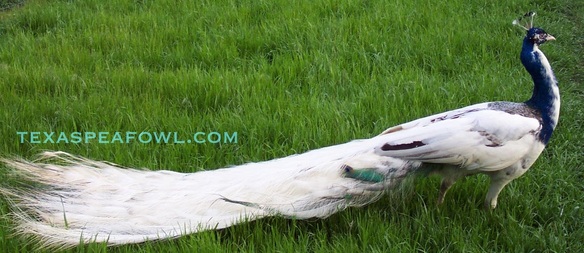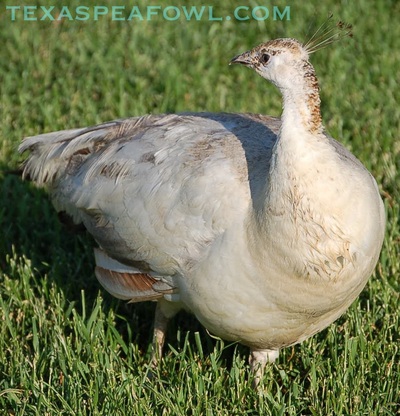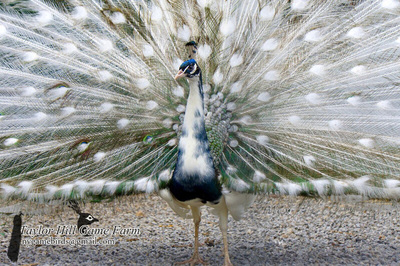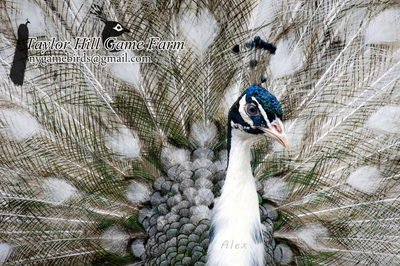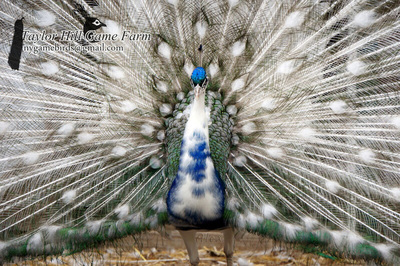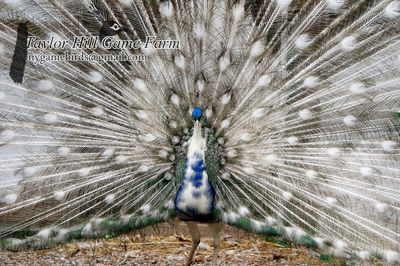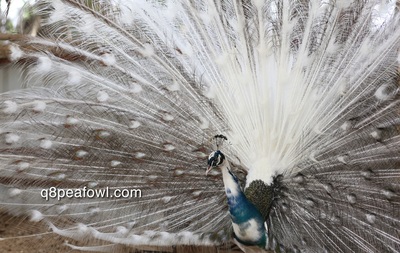Indian Blue Black Shoulder Silver Pied (BSSP)
|
*Please click on images to enlarge
|
COLOR:
Blue is the natural, unmutated color of the Indian peafowl, also known as the wild type (aka the type found in the wild).
CONTENTS:
This page contains photos of blues with the blackshoulder, pied, AND white eye pattern mutations (wild type color, pied pattern, white eye pattern), in the silver pied phenotype.
PATTERN DESCRIPTION:
Blackshoulder pied white eye is a mostly white bird with solid color replacing the barred color on the wing for males, colored patches over the body, and white patches covering the eye markings of the eye feathers in the male's train, and usually have a pale to white tail. Females will be mostly white, with color flecked in patches over their main body. Females may have a rust band around their necks or just flecked color, rusty color on top of their heads or just flecked color, and a white or very pale-colored, frosty tail. The colored patches on blackshoulder silver pied birds may be paler than normal blackshoulder silver pied, and may show white tips or heavy white flecking on colored feathers. Both sexes usually have white flight feathers.
Blackshoulder birds of all colors are born looking nearly white, with very pale tan flight feathers, but silver pied birds often have white flight feathers that obscure the tan. As the birds mature, speckling and marbling appears on the new feathers of each molt. By around 3 months of age, males will begin to develop solid saddle feathers with paler "arrows" in the center of each feather. Females will begin to speckle out. Blackshoulder silver pied males should have "frosted" saddle feathers.
GENETICS:
Blackshoulder is a single-expression autosomal recessive gene for pattern. Pied is a combination of two incomplete dominant genes (white + pied). White-eye is a single-expression autosomal incomplete dominant gene for pattern. Pied and white-eye genes travel independently of the blackshoulder gene and each other. Please see the individual entries for blackshoulder, pied, and white-eye for more information on the individual morphs.
NOTES:
Blackshoulder is a bit of a misnomer, as the gene only causes a black shoulder in a wild type bird. In truth, it causes a solid wing instead of a barred wing pattern, leading some to refer to this as "solid wing." Blackshoulder and solid wing are the same mutation by different names, just as "barred wing" and "wild wing" both refer to the wild type wing pattern.
Despite that both are genetically "pied + white eye," the main difference between pied white eye and silver pied morphs is whether or not the saddle is frosted. A pied-looking bird with a normal saddle is pied white eye, a pied-looking bird with a frosted/silvered saddle is a silver pied. Silver pied also usually have 80%+ white coverage, but not always, and normal pied can have 80% or less coverage, but can have more, so this is not a very good measure to go by.
Blue is the natural, unmutated color of the Indian peafowl, also known as the wild type (aka the type found in the wild).
CONTENTS:
This page contains photos of blues with the blackshoulder, pied, AND white eye pattern mutations (wild type color, pied pattern, white eye pattern), in the silver pied phenotype.
PATTERN DESCRIPTION:
Blackshoulder pied white eye is a mostly white bird with solid color replacing the barred color on the wing for males, colored patches over the body, and white patches covering the eye markings of the eye feathers in the male's train, and usually have a pale to white tail. Females will be mostly white, with color flecked in patches over their main body. Females may have a rust band around their necks or just flecked color, rusty color on top of their heads or just flecked color, and a white or very pale-colored, frosty tail. The colored patches on blackshoulder silver pied birds may be paler than normal blackshoulder silver pied, and may show white tips or heavy white flecking on colored feathers. Both sexes usually have white flight feathers.
Blackshoulder birds of all colors are born looking nearly white, with very pale tan flight feathers, but silver pied birds often have white flight feathers that obscure the tan. As the birds mature, speckling and marbling appears on the new feathers of each molt. By around 3 months of age, males will begin to develop solid saddle feathers with paler "arrows" in the center of each feather. Females will begin to speckle out. Blackshoulder silver pied males should have "frosted" saddle feathers.
GENETICS:
Blackshoulder is a single-expression autosomal recessive gene for pattern. Pied is a combination of two incomplete dominant genes (white + pied). White-eye is a single-expression autosomal incomplete dominant gene for pattern. Pied and white-eye genes travel independently of the blackshoulder gene and each other. Please see the individual entries for blackshoulder, pied, and white-eye for more information on the individual morphs.
NOTES:
Blackshoulder is a bit of a misnomer, as the gene only causes a black shoulder in a wild type bird. In truth, it causes a solid wing instead of a barred wing pattern, leading some to refer to this as "solid wing." Blackshoulder and solid wing are the same mutation by different names, just as "barred wing" and "wild wing" both refer to the wild type wing pattern.
Despite that both are genetically "pied + white eye," the main difference between pied white eye and silver pied morphs is whether or not the saddle is frosted. A pied-looking bird with a normal saddle is pied white eye, a pied-looking bird with a frosted/silvered saddle is a silver pied. Silver pied also usually have 80%+ white coverage, but not always, and normal pied can have 80% or less coverage, but can have more, so this is not a very good measure to go by.
